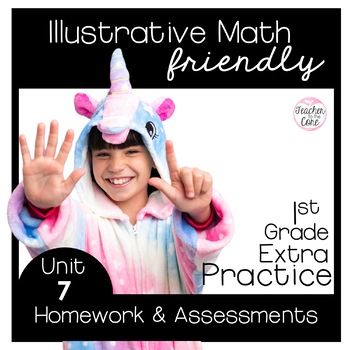Illustrative Math Homework and Assessments Unit 7
Teacher to the Core
12.9k Followers
Grade Levels
1st
Subjects
Resource Type
Standards
CCSS1.MD.B.3
CCSS1.G.A.1
CCSS1.G.A.2
CCSS1.G.A.3
CCSSMP1
Formats Included
- PDF
Pages
26 pages
Teacher to the Core
12.9k Followers
What educators are saying
This is a great resource to provide extra practice to go along with Illustrative Math lessons. They are kid friendly and engaging.
I use this resource for homework/extra practice to support learning with Illustrative Math. Each page aligns nicely to the daily lesson.
Also included in
- This is a bundle of all first grade Illustrative Math-Friendly Units 1-8. You will have an extra practice for every lesson in the IM math program. 146 practice pages that can be used as year-long:Cool-downs or homeworkUnit 1 - 14 lessonsUnit 2 - 22 lessons Unit 3 - 29 lessonsUnit 4 - 23 lessonsUnitPrice $70.00Original Price $80.00Save $10.00
Description
This resource is an Illustrative Mathematics friendly unit. Use for extra practice / homework and to monitor understanding with 4 assessments. It is carefully designed to be Illustrative Math friendly and kid-friendly.
Extra Practice / Homework and 4 Assessments : (See every page in the preview)
- 1 extra practice page per lesson
- 17 lessons in this resource !!!
- Supports vocabulary
- Lesson format is extended here
- Kid-friendly graphics and topics
- Supports game-play
- Can be sent home as homework or used in class
- Each page can be used as a quiz, exit ticket, or cool down
- Can be used outside of the IM program as standards-based math practice.
- 4 Assessments
Assessments
- Section A Part 1
- Section A Part 2
- Section B
- Section C
Will you be making other units?
- Yes!
- I need this extra practice as much as you do!
- I plan to post a unit every few weeks.
What Units are available?
- ⭐ Unit 1 Posted August 25th
- ⭐ Unit 2 Posted Sep 7
- ⭐ Unit 3 Posted Sep 18th
- ⭐ Unit 4 Posted October 1
- ⭐ Unit 5 Posted October 9
- ⭐ Unit 6 Posted October 30
- ⭐ Unit 7 Posted Dec 6
- ⭐ Unit 8 Wahooooo!
Will you bundle?
- ⭐ Unit 1-8 Bundle is posted!
Total Pages
26 pages
Answer Key
N/A
Teaching Duration
3 Weeks
Report this resource to TPT
Reported resources will be reviewed by our team. Report this resource to let us know if this resource violates TPT’s content guidelines.
Standards
to see state-specific standards (only available in the US).
CCSS1.MD.B.3
Tell and write time in hours and half-hours using analog and digital clocks.
CCSS1.G.A.1
Distinguish between defining attributes (e.g., triangles are closed and three-sided) versus non-defining attributes (e.g., color, orientation, overall size); build and draw shapes to possess defining attributes.
CCSS1.G.A.2
Compose two-dimensional shapes (rectangles, squares, trapezoids, triangles, half-circles, and quarter-circles) or three-dimensional shapes (cubes, right rectangular prisms, right circular cones, and right circular cylinders) to create a composite shape, and compose new shapes from the composite shape.
CCSS1.G.A.3
Partition circles and rectangles into two and four equal shares, describe the shares using the words halves, fourths, and quarters, and use the phrases half of, fourth of, and quarter of. Describe the whole as two of, or four of the shares. Understand for these examples that decomposing into more equal shares creates smaller shares.
CCSSMP1
Make sense of problems and persevere in solving them. Mathematically proficient students start by explaining to themselves the meaning of a problem and looking for entry points to its solution. They analyze givens, constraints, relationships, and goals. They make conjectures about the form and meaning of the solution and plan a solution pathway rather than simply jumping into a solution attempt. They consider analogous problems, and try special cases and simpler forms of the original problem in order to gain insight into its solution. They monitor and evaluate their progress and change course if necessary. Older students might, depending on the context of the problem, transform algebraic expressions or change the viewing window on their graphing calculator to get the information they need. Mathematically proficient students can explain correspondences between equations, verbal descriptions, tables, and graphs or draw diagrams of important features and relationships, graph data, and search for regularity or trends. Younger students might rely on using concrete objects or pictures to help conceptualize and solve a problem. Mathematically proficient students check their answers to problems using a different method, and they continually ask themselves, "Does this make sense?" They can understand the approaches of others to solving complex problems and identify correspondences between different approaches.






